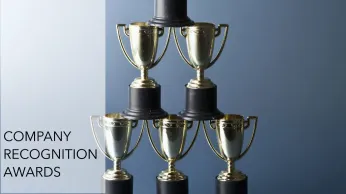15 idées de récompenses pour les employés
15 récompenses pour les employés afin de stimuler l'engagement et la motivation. Améliorez le moral de vos employés grâce à des idées de reconnaissance significatives et efficaces.
Sur cette page
Sur le marché du travail actuel, où l'engagement des salariés est en baisse, des programmes d'incitation efficaces peuvent faire une différence significative pour retenir les meilleurs talents et favoriser un environnement de travail positif.
Prenons l'exemple d'Empuls . Empuls est une plateforme d'engagement des employés qui offre une gamme de récompenses incitatives. Empuls permet aux organisations de créer des programmes d'incitation personnalisés, adaptés aux divers besoins et préférences de leurs employés. Ses principales caractéristiques sont la reconnaissance en temps réel, la gamification et les concours, la reconnaissance sociale et l'intégration transparente avec les systèmes de ressources humaines existants.
En tirant parti de ces caractéristiques, les organisations peuvent mettre au point des programmes d'incitation solides qui stimulent considérablement l'engagement, la productivité et la fidélisation des employés.
Selon un rapport, un programme d'incitation bien structuré peut augmenter la productivité jusqu'à 44% et de diminuer le taux de rotation du personnel de de 14 à 26 %. Investir dans des mesures d'incitation efficaces à l'intention des salariés est une décision stratégique qui apporte des avantages substantiels tant aux salariés qu'à l'organisation.
Quelle est l'incitation à la récompense pour les employés ?
Les mesures d'incitation à la rémunération des salariés englobent divers programmes et systèmes de reconnaissance conçus pour motiver les salariés, améliorer leurs performances et accroître leur engagement sur le lieu de travail.
Ces mesures incitatives visent à renforcer les comportements positifs, à stimuler des niveaux de performance plus élevés et à inspirer une plus grande productivité. Selon la recherche, les programmes d'incitation bien mis en œuvre peuvent augmenter de manière significative la rétention des employés, accroître leur satisfaction au travail et renforcer leur engagement envers les objectifs de l'organisation.
En offrant des récompenses significatives, les entreprises peuvent créer une main-d'œuvre plus motivée et plus dévouée, ce qui contribue en fin de compte à la réussite globale de l'organisation.
Une étude a montré que les voyages de motivation sont utilisés par 46% des entreprises américaines. Les récompenses non monétaires sont les mesures d'incitation les plus appréciées par les employés. L'étude indique également que les récompenses non monétaires ont tendance à être mémorisées par les gens plus longtemps que les récompenses en espèces.
Les principaux avantages des primes d'encouragement pour les salariés :
- Augmenter la productivité de 14%car les employés sont motivés pour atteindre les objectifs de performance.
- Les salariés sont également 73% moins susceptibles de se sentir épuisés lorsqu'ils sont régulièrement reconnus.
- Économiser sur les coûts de recrutement, de rotation et de faible productivité.
- Atteindre les principaux objectifs de l'entreprise, en favorisant la réussite de l'organisation.
Pourquoi récompenser les employés ?
L'incitation des employés est un aspect crucial de la gestion organisationnelle qui peut avoir un impact significatif sur la productivité, la satisfaction au travail et le moral général. En comprenant les théories psychologiques qui sous-tendent la motivation, les entreprises peuvent créer des programmes d'incitation efficaces qui non seulement répondent aux besoins fondamentaux des employés, mais favorisent également un sentiment plus profond d'engagement et de satisfaction.
La théorie des deux facteurs du psychologue Frederick Herzberg théorie des deux facteurs fournit un cadre fondamental pour comprendre la motivation des employés.
Selon Herzberg, les facteurs liés au lieu de travail peuvent être divisés en deux catégories : les facteurs d'hygiène et les facteurs de motivation. Les facteurs d'hygiène, tels qu'une rémunération appropriée, la sécurité sur le lieu de travail et les avantages sociaux, sont essentiels pour prévenir l'insatisfaction.
Cependant, une fois ces besoins fondamentaux satisfaits, d'autres mesures incitatives, telles que la reconnaissance, un travail stimulant et des possibilités d'épanouissement personnel, peuvent améliorer considérablement la satisfaction des employés.
Cette distinction est essentielle lors de l'élaboration de programmes d'incitation. Les organisations doivent d'abord s'assurer que les facteurs d'hygiène sont correctement pris en compte pour éliminer l'insatisfaction. Une fois cette base établie, elles peuvent se concentrer sur la mise en œuvre de facteurs de motivation qui augmentent l'engagement et la satisfaction des employés.
Selon une étude, les organisations qui mettent en œuvre des programmes d'incitation efficaces enregistrent des taux de rotation plus faibles et des taux d'engagement des employés plus élevés. En outre, un rapport Gallup a révélé que les entreprises dont les employés sont engagés surpassent leurs concurrents de 147 % en termes de bénéfices par action. Cela met en évidence les avantages financiers de l'investissement dans la motivation des employés.
15 Types de récompenses et d'incitations pour les employés
Voici 15 types de récompenses pour les employés :
1. Reconnaissance par les pairs
La reconnaissance de pair à pair est un geste d'appréciation significatif tant pour celui qui la donne que pour celui qui la reçoit. Complétant les méthodes de reconnaissance descendante et ascendante, elle offre une perspective globale à 360 degrés sur les récompenses et la reconnaissance au sein des organisations.
Si la reconnaissance hiérarchique est la norme dans de nombreux secteurs d'activité, les éloges de la part des collègues peuvent considérablement améliorer le moral des employés. Une simple note de félicitations ou une reconnaissance verbale de la part d'un collègue peut avoir un impact considérable.
De nombreuses entreprises dotées de programmes de récompense des salariés de premier plan intègrent la reconnaissance entre pairs, ce qui permet aux collègues et aux responsables de reconnaître et de récompenser les contributions des uns et des autres.
Par exemple, Vodafoneest un réseau mondial qui propose des programmes "peer-to-peer" et "manager-to-employee" pour reconnaître et récompenser les performances exceptionnelles. Il s'agit notamment d'initiatives telles que Vodafone Stars, dans le cadre desquelles les employés peuvent envoyer des cartes électroniques SST (Speed, Simplicity, and Trust) pour récompenser instantanément leurs collègues dans différentes fonctions.
En outre, des super-étoiles sont décernées à ceux qui font constamment preuve de rapidité, de simplicité et de confiance. Les employés peuvent être choisis par des collègues fonctionnels ou interfonctionnels, des chefs d'équipe ou des managers plusieurs fois par mois. Les Megastars sont décernés à ceux qui incarnent l'esprit Vodafone et servent de modèles aux autres.
Vous pouvez offrir des expériences aux employés en guise de récompense.
2. Dégustations de vins et visites de vignobles
Récompensez vos employés en leur proposant une visite de vignoble et une séance d'éducation à l'œnologie. Cette expérience leur permet de rencontrer des experts en vinification, déguster des vins de qualitéCette expérience leur permet de rencontrer des experts en vinification, de déguster des vins fins et d'en apprendre davantage sur le processus de vinification, y compris sur les quatre S de la dégustation du vin : Voir, Tourbillonner, Sentir et Siroter. C'est une sortie idéale pour les débutants comme pour les amateurs de vin chevronnés !
3. Visite audio autoguidée du Yosemite
Pour les employés, proposez un audioguide MP3 accompagné d'une carte détaillée de la visite. visite de l'excursion. Cette expérience autoguidée leur permet d'explorer la magnifique Sierra Nevada lors d'une randonnée le long du Panorama Trail dans le parc national de Yosemite.
4. Croisière au coucher du soleil
Offrez à vos employés une aventure unique avec un tour en voilier à Florida City. Ils découvriront les sites emblématiques d'un point de vue nouveau, sentiront le vent dans leurs cheveux et profiteront du soleil en glissant sur le port. Ils peuvent choisir parmi les tours de voile publics ou opter pour un charter privé pour une expérience plus intime. Cette sortie inoubliable les laissera détendus et inspirés.
Selon les employés de l'entreprise, cette réussite est en grande partie due à ses politiques R&R (récompenses et reconnaissance) efficaces.
Lorsqu'une employée très productive de Simplus a décidé de démissionner pour cause d'épuisement professionnel, l'entreprise a agi rapidement.
Elle lui a immédiatement offert un mois de congé dans le cadre de son programme de R&R, ce qui lui a permis de revenir plus fraîche et plus efficace.
Si l'entreprise avait ignoré sa situation ou retardé la mise en œuvre de son programme de R&R, le résultat aurait pu être tout à fait différent.
5. La visite immersive originale de Van Gogh à Las Vegas
Récompensez vos employés en leur faisant vivre une expérience artistique sans précédent dans l'exposition immersive ORIGINAL Van Gogh, située au Shops at Crystals, à côté de l'ARIA Resort & Casino de Las Vegas. Ils entreront dans un monde fascinant où les chefs-d'œuvre de Van Gogh prennent vie d'une manière vraiment immersive et inoubliable. Cette sortie unique est idéale pour stimuler la créativité et offrir une aventure culturelle mémorable.
6. Carte cadeau Starbucks
Récompensez vos employés amateurs de café en leur offrant une carte cadeau Starbucks. Starbucks est la destination préférée des amateurs de café. Un bon d'achat Starbucks, échangeable dans n'importe quel magasin, est le cadeau idéal pour votre équipe pendant les fêtes de fin d'année !
7. Carte-cadeau Hollister
Hollister, connu pour son style californien branché, propose une large gamme de vêtements comprenant des jeans, des shorts, des débardeurs, des pulls, des sweatshirts, des sweats à capuche, des tees et des vestes. Offrez à vos employés le dernier cri en matière de mode décontractée et cool avec une carte-cadeau Hollisterqui leur permet de choisir leurs styles préférés et de rester à la mode.
8. Bon d'achat Whole Foods Market USA
Faire ses courses dans l'épicerie la plus saine d'Amérique est exactement ce dont vos employés ont besoin pour rester fidèles à leurs objectifs de santé. Offrez-leur un chèque-cadeau Whole Foods Market USA aujourd'hui !
9. Options d'achat d'actions
Les options d'achat d'actions sont un type de rémunération qui permet aux salariés d'acheter des actions de l'entreprise à un prix fixe, généralement inférieur à la valeur actuelle du marché. Cette forme de rémunération offre aux salariés une participation au succès de l'entreprise et la possibilité d'un gain financier si le prix de l'action augmente au fil du temps.
La valeur des actions de Microsoft ayant considérablement augmenté, ces options ont transformé de nombreux employés de longue date en "millionnaires de Microsoft", grâce aux gains financiers substantiels générés par leurs actions.
Bien que l'entreprise ait depuis lors décidé d'offrir davantage d'unités d'actions restreintes (RSU) au lieu des options d'achat d'actions traditionnelles, l'idée fondamentale reste la même : lier une partie de la rémunération des employés à la performance des actions de l'entreprise permet d'aligner les intérêts des employés sur la réussite à long terme de l'entreprise.
10. Possibilités de développement professionnel
Investir dans la croissance et le développement continus des employés à long terme, c'est reconnaître la valeur croissante de leurs compétences et de leur expertise au fur et à mesure qu'ils restent dans l'entreprise. L'accent mis sur le développement professionnel témoigne d'un engagement à améliorer leurs capacités et à favoriser leur progression de carrière.
11. Possibilités de mentorat
Promouvoir l'implication des employés de longue date en tant que mentors au sein de l'organisation, ce qui leur permet de transmettre leurs connaissances et leur expérience aux nouveaux membres de l'équipe.
12. Non-utilisation des performances
Les primes de performance sont une méthode traditionnelle mais efficace pour relier directement les récompenses financières aux réalisations individuelles. Ces primes peuvent être basées sur des indicateurs spécifiques, sur l'achèvement de projets ou sur le dépassement d'objectifs. En liant les primes aux objectifs de l'organisation, les employés sont récompensés pour leurs contributions et s'impliquent davantage dans la réussite globale de l'entreprise.
Les employés qui contribuent de manière significative à des projets, franchissent des étapes importantes ou dépassent les objectifs de performance peuvent se voir attribuer ces primes dans le cadre de leur rémunération.
Ces primes visent à reconnaître les réalisations et à encourager les employés à maintenir un niveau d'excellence élevé dans leurs fonctions.
13. Charité
Intégrer des initiatives caritatives dans les récompenses offertes aux employés favorise une culture de la générosité et de la responsabilité sociale. Les entreprises peuvent organiser des actions de bénévolat, des collectes de dons ou des projets de service communautaire, permettant ainsi aux employés de soutenir des causes qui les passionnent.
En s'engageant dans ces activités caritatives, les employés ont un sentiment d'accomplissement et d'utilité, tout en constatant que l'organisation apprécie à la fois leurs contributions individuelles et l'impact collectif sur l'ensemble de la communauté.
14. Cartes prépayées
Les cartes prépayées sont une forme flexible et appréciée d'incitation à la récompense pour les employés, offrant aux individus la liberté de décider comment ils veulent utiliser leur reconnaissance. Qu'il s'agisse de shopping, de restauration ou d'achats en ligne, ces cartes apportent une touche personnalisée.
En s'adaptant aux diverses préférences des employés, les cartes prépayées permettent aux bénéficiaires de choisir des récompenses qui correspondent à leurs goûts uniques. Cette approche pratique et personnalisable garantit que chaque employé reçoit une récompense qui correspond vraiment à ses intérêts, ce qui renforce son sentiment d'appréciation et de satisfaction.
Ces cartes prépayées peuvent être utilisées chez différents commerçants, y compris des détaillants en ligne, des restaurants ou pour des dépenses générales, ce qui donne aux employés la liberté de choisir les récompenses qui correspondent le mieux à leurs préférences individuelles.
15. Remboursement des frais d'éducation
Le remboursement des frais de formation témoigne d'un engagement en faveur de la réussite à long terme des salariés en les aidant à poursuivre des études supérieures ou à obtenir des certifications pertinentes. En proposant de tels programmes, les organisations encouragent la formation continue et se positionnent en tant que championnes du développement des employés.
Investir dans l'éducation permet de créer une main-d'œuvre plus qualifiée et mieux informée, ce qui peut, à son tour, améliorer les performances globales de l'entreprise.
Cette initiative comprend le remboursement des frais liés aux certifications professionnelles, aux diplômes avancés et aux cours spécialisés.
En encourageant la formation continue, Microsoft aide ses employés à rester à jour dans leur domaine et favorise leur développement professionnel au sein de l'entreprise.
Étude de cas
H&M, leader mondial de la mode avec plus de 171 000 employés, exploite neuf marques dans 4 900 magasins répartis sur plus de 73 sites. Son objectif est de proposer une mode durable et de qualité à des prix compétitifs.
Défi : H&M a rencontré plusieurs problèmes avec son système interne de récompenses en espèces :
- Récompenses en espèces : Les taux d'imposition forfaitaires réduisent la valeur réelle des récompenses.
- Logistique : La coordination avec plusieurs équipes a alourdi le processus de distribution.
- Conversion des devises : Les employés sur place ont vu la valeur de leurs récompenses diminuer en raison du taux de change et des taxes.
Évaluation : L'équipe des ressources humaines de H&M a identifié le besoin d'un système de récompenses basé sur des points à travers des enquêtes auprès des employés. Elle a choisi Empuls pour son :
- Service à la clientèle : Excellent retour d'expérience lors d'un essai pilote.
- Simplicité : Rationalisation de l'attribution des récompenses et du traitement des taxes.
- Une portée mondiale : Prise en charge de plusieurs devises et de récompenses internationales.
La solution : Empuls a mis en place un système de récompenses basé sur des points offrant un éventail d'options, telles que des expériences, des chèques-cadeaux et des avantages. Ce système comprenait
- Des récompenses variées : Répondre aux besoins de différentes catégories comme les récompenses basées sur les performances, la durée d'emploi, les récompenses pour les managers et les équipes.
- Économies d'impôts : Valeur totale de la récompense reçue sans déduction fiscale forfaitaire.
- Efficacité accrue : La simplification des processus a permis de réduire les efforts de coordination et d'augmenter les nominations de pairs et de responsables.
Résultats : Après la mise en œuvre, H&M a constaté des améliorations significatives. Ils ont remarqué :
- 52% des employés ont été nominés et 10% ont été récompensés.
- Amélioration des processus de récompense et de la satisfaction des employés.
- Amélioration de l'engagement des employés sur place grâce à des options spécifiques à la région.
Les tests de H&M et les commentaires des employés ont confirmé le succès du programme Empuls . Cela met en évidence son impact positif sur leurs systèmes de récompense.
Meilleures pratiques de l'étude de cas
Les meilleures pratiques tirées de l'étude de cas sont les suivantes
1. Un retour d'information régulier de la part des employés
Il est essentiel de mener des enquêtes auprès des salariés tous les six mois pour comprendre leurs besoins et leurs préférences. Cette pratique permet aux organisations d'identifier les points à améliorer dans leurs systèmes de rémunération.
2. Adopter un système de récompense par points
La mise en place d'un système de récompenses basé sur des points offre flexibilité et variété, permettant aux employés de choisir les récompenses qui leur conviennent. Cette approche répond aux diverses préférences des employés et renforce leur engagement.
3. Reconnaissance basée sur les performances
L'établissement de catégories claires pour les récompenses, telles que les récompenses basées sur les performances, les récompenses de titularisation et les récompenses d'équipe, garantit que la reconnaissance est alignée sur les objectifs de l'organisation et les contributions des employés.
Pourquoi choisir Empuls pour récompenser les employés
Choisir Empuls pour les récompenses et les incitations pour les employés, car il offre une solution complète pour stimuler l'engagement et la satisfaction des employés en intégrant des systèmes de reconnaissance et de retour d'information.
La plateforme fournit des informations en temps réel par le biais d'enquêtes et d'évaluations eNPS, tout en encourageant une culture de l'appréciation grâce à la reconnaissance par les pairs et à la gamification des récompenses. Son vaste catalogue de récompenses comprend des expériences, des marchandises et d'autres avantages, garantissant des options d'échange significatives pour les employés.
L'intégration de la gamification favorise une compétition saine et une reconnaissance immédiate, améliorant ainsi l'environnement de travail. Les organisations qui utilisent Empuls constatent souvent une augmentation de la productivité et de la satisfaction au travail, car les employés récompensés ont tendance à reproduire des comportements très performants.
Globalement, Empuls simplifie récompenses pour les employés et améliore la culture du lieu de travail, ce qui en fait un outil efficace pour motiver le personnel et améliorer la fidélisation.
Planifiez une démonstration maintenant !
FAQs
Quels sont les exemples et les types de récompenses pour les salariés ?
Exemples et types de récompenses pour les salariés :
1. Récompenses monétaires :
- Primes : Récompenses en espèces basées sur les performances, accordées périodiquement ou pour la réalisation d'objectifs spécifiques.
- Cartes-cadeaux : Cartes prépayées que les employés peuvent utiliser chez différents détaillants ou sur des sites de vente en ligne.
- Augmentations de salaire : Augmentation permanente du salaire de base en récompense de performances élevées et constantes.
2. Récompenses non monétaires :
- Reconnaissance publique : Reconnaissance des réalisations dans les réunions ou les bulletins d'information de l'entreprise.
- Temps libre supplémentaire : Jours de vacances supplémentaires ou temps personnel en récompense d'un travail exceptionnel.
- Développement professionnel : Possibilités de formation continue, de certification ou de participation à des conférences.
3. Récompenses expérientielles
- Bons de voyage : Réductions ou bons complets pour des vacances ou des voyages.
- Événements exclusifs : Invitations à des événements, dîners ou sorties spéciaux organisés par l'entreprise.
- Expériences uniques : Occasions d'assister à des concerts, à des événements sportifs ou à d'autres activités spéciales.
Qu'est-ce que l'incitation à la récompense pour les employés ?
Les récompenses sont des avantages accordés aux employés en reconnaissance de leurs performances, de leurs réalisations ou des étapes franchies, afin de renforcer leur motivation et leur satisfaction au travail.
À quelle fréquence dois-je motiver mes employés ?
La fréquence des mesures d'incitation peut varier en fonction des objectifs du programme d'incitation et de la culture de l'entreprise. En règle générale, les primes peuvent être offertes :
- Mensuel ou trimestriel : Pour des performances continues ou la réalisation d'objectifs spécifiques à court terme.
- Annuellement : Pour les étapes importantes, les réalisations à long terme ou les évaluations globales des performances.
- Récompenses ponctuelles : Les récompenses ponctuelles sont accordées de manière ad hoc pour des réalisations ou des comportements exceptionnels, au fur et à mesure qu'ils se produisent.
Les programmes d'incitation sont-ils une bonne tactique commerciale ?
Oui, les programmes d'incitation sont généralement considérés comme une bonne tactique commerciale parce qu'ils.. :
- Stimuler la motivation : Ils encouragent les employés à donner le meilleur d'eux-mêmes en alignant leurs efforts sur les objectifs de l'entreprise.
- Améliorer le moral : Reconnaître et récompenser les employés augmente la satisfaction au travail et crée un environnement de travail positif.
- Augmenter la rétention : Des programmes d'incitation bien structurés peuvent réduire le taux de rotation en faisant en sorte que les employés se sentent valorisés et engagés.
- Favoriser les performances : Ils peuvent conduire à une plus grande productivité et à la réalisation des objectifs de l'entreprise en fournissant des incitations claires à l'excellence.
Pourquoi les primes d'encouragement sont-elles importantes pour les employés ?
Les primes d'encouragement sont importantes pour les employés car elles.. :
- Renforcer la motivation : Ils fournissent des objectifs tangibles et de la reconnaissance, ce qui incite les employés à donner le meilleur d'eux-mêmes.
- Accroître la satisfaction au travail : Les récompenses et la reconnaissance permettent aux employés de se sentir valorisés et appréciés, ce qui se traduit par une plus grande satisfaction dans leur rôle.
- Encourager les comportements positifs : Les incitations renforcent les comportements et les réalisations souhaitables, favorisant ainsi une culture de l'excellence et de l'amélioration continue.
- Améliorer la fidélisation : En offrant des récompenses qui correspondent aux intérêts des employés, les entreprises peuvent favoriser la loyauté et réduire le taux de rotation.
- Stimuler l'engagement : Les mesures d'incitation permettent aux employés de rester engagés et de s'investir dans leur travail, contribuant ainsi à la réussite globale de l'organisation.
Comment les primes d'encouragement peuvent-elles influencer les performances des employés ?
Des mesures d'incitation efficaces peuvent conduire à une augmentation de la productivité, à une plus grande satisfaction au travail et à une meilleure fidélisation des employés en les motivant à se surpasser et à se sentir valorisés.













